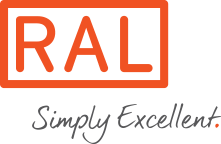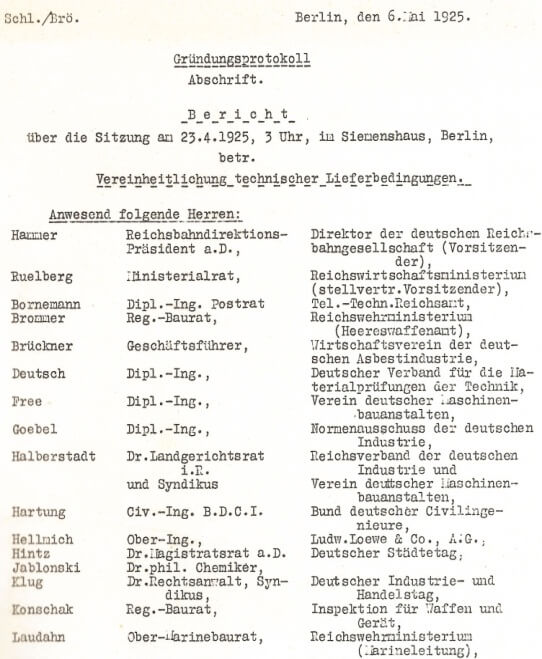The “Reichsausschuss für Lieferbedingungen” provides the name
The “Reichs-Ausschuss für Lieferbedingungen” was founded on 23 April 1925 and the abbreviation RAL has been retained to this day. Alongside numerous associations, representatives of the government at the time also participated in the foundation of RAL under the auspices of the Reichskuratorium für Wirtschaftlichkeit (RKW – Government Economy Committee). The RKW was under the control of the Reichswirtschaftsministerium (Ministry of Economics). However, RAL was already an independent institution at this time. RAL acquired the status of a legally registered association a short while later and became an independent legal entity. The association protected the name RAL – still characteristic... →
A boom period for Germany during the Weimar Republic
A boom period for Germany during the Weimar Republic – calls for rationalisation within the economy RAL has set the standard for continuously and independently controlled quality since 1925 Germany found itself in a period of economic recovery in 1925. The country had overcome the crisis after the First World War and the increasing level of automation and electrification was promoting technical advancements. In addition, mass industrial production was developing at a fast pace. These factors created the framework conditions and acted as the trigger for suppliers – and also consumers – to demand a orderly system for quality assurance... →
RAL clearly defines colour tones
The history of RAL Colours began in a period of economic transformation: the first series-production automobile was being manufactured, the age of the talking movies had begun and an economic recovery in Germany had resulted in a rise in prosperity. RAL set the first binding standards in 1927 with a collection of the 40 most widely used colours in industry and public life. These 40 colours were defined for the first time and uniquely classified using RAL numbers. Today, the 2,328 RAL colours are a defining worldwide standard used in industry, trade and design, as well as by professional users... →
The first users of the RAL GÜTEZEICHEN (Quality Marks)
The first users of the RAL Gütezeichen (Quality Marks) came from large established associations that may appear a little exotic from today’s perspective. These included, for example, the quality mark for the “Hands in oath labelling association”, for products made out of bast fibres from the flax plant or for type-specific plastic mouldings for the Technical Association of Producers whose quality marks still existed up to the end of 1993. As the concept of quality assurance came increasingly to the forefront, this was reflected in the association’s name. The new name incorporated the idea of quality and RAL was now... →
No possibilities for developing and implementing regulations under private law
As a voluntary, self-regulatory body in the German economy, RAL stood opposed to the dirigist economic policies of the National Socialists. The ambition of the Third Reich to gain absolute autarchy was hostile to the idea of free world trade and fostered Germany’s isolation on the global market. The interest from manufacturers for RAL Gütezeichen (Quality Marks) disappeared. In the middle of the war, the responsible ministry in the Third Reich issued a state quality mark ordinance in 1942. RAL had thus lost its area of responsibility. There was no longer voluntary, self-regulation of the German economy in the form... →
RAL in the social market economy
After the Second World War, it took a few years before the RAL quality assurance system and quality marks began to play a role again in the economy. The success of the new social market economy and the associated economic recovery quickly made it clear how important it was to have an independent institution that guaranteed unambiguous and reliable quality assurance and technical delivery conditions. In 1952, RAL became affiliated to the Deutschen Normenausschuss (DNA – German Institute for Standardization) and was given the name: Ausschuss für Lieferbedingungen und Gütesicherung (Committee for Delivery Conditions and Quality Assurance). In contrast to... →
RAL Fundamental Guidelines for Quality Marks
In collaboration with representatives from the German economy, testing institutions, consumer organisations and the responsible state ministries, the cornerstones of the quality assurance system were formulated and published for the first time in August 1954 under the title of “RAL-Grundsätze für Gütezeichen” (RAL Fundamental Guidelines for Quality Marks).
Renamed RAL e.V. again after 20 years
Twenty years after the re-launch of RAL, its status as a registered association with its own legal identity was restored. The Executive Board of RAL has since been made up of representatives from leading economic organisations, consumers, federal and state authorities and four full members from RAL who are elected at the AGM. The board of RAL – previously the Advisory Board, today known as the Board of Trustees – reflected the balance of the business partners concerned and demonstrated the strict neutrality of RAL.
RAL serving the environment
As a result of its recognised expertise in the issuing of quality marks, the Federal Environment Agency assigned RAL the new responsibility of awarding the Blue Angel in December 1978. Therefore, RAL assumed a pioneering role as an environmental service provider from the very beginning.
RAL receives a new name
RAL receives a new name: RAL Deutsches Institut für Gütesicherung und Kennzeichnung e. V. This non-profit organisation placed their focus even more strongly on the organisation and functions of the quality assurance system and its labelling expertise.
Fundamental Guidelines for Quality Marks published in the Federal Gazette
In order to underline the significance of the RAL quality assurance system, the “Fundamental Guidelines for Quality Marks” were published following a number of amendments on 9 August 1985 in the German Federal Gazette by the Federal Ministry of Economics.
RAL named a “Competent Body”
The European Commission created the joint EU environmental label the “EU Flower” – today called the EU Ecolabel – in 1992. As a result of its long-standing experience in environmental labelling, RAL was viewed as a suitable partner to take on the role of awarding authority by the Federal Ministry for the Environment, Nature Conservation and Nuclear Safety and the Federal Environment Agency. In November 1992, RAL was issued with the task of awarding the European environmental label in Germany and was named a “Competent Body” by the European Commission.
A new legal form for RAL Colours and Ecolabels
RAL Colours & Ecolabels given a new legal form: The RAL Deutsches Institut für Gütesicherung und Kennzeichnung e. V. formed a new company called RAL gGmbH to handle its RAL Colours and Ecolabels business areas. The company is a 100% subsidiary of the RAL Deutsches Institut für Gütesicherung und Kennzeichnung e. V. and was entered in the commercial register on 29. August 2008.
RAL launches the new LOGO LICENCE business area
Quality and consumer protection has been the job of RAL for many decades. Against this background, companies can have their brands independently marketed in the RAL LOGO LICENCE business area. RAL has been commissioned to carry out this task by Stiftung Warentest since 2013. Companies who want to advertise their tested products or services using the test logo from Stiftung Warentest can acquire a corresponding licence from RAL. Thanks to continuous monitoring of the market, RAL also ensures that the label is not being misused.
Foundation of the RAL ACADEMY
We pass on our specialist knowledge to interested parties and a variety of occupational groups at our seminars, workshops, presentations and talks. The provision of high quality further training to colour designers is a key focus of the RAL ACADEMY.
Laying of the foundation stone for the new RAL building
RAL Deutsches Institut für Gütesicherung und Kennzeichnung e.V. is moving to Bonn in early 2017. The institute found by the German industry back in 1925 is thus making a long-term commitment to the location of Bonn. The laying of the foundation stone for the new RAL building was celebrated at the new “Am Mühlenbach” business park in the Beuel district of Bonn. RAL Deutsches Institut für Gütesicherung und Kennzeichnung e.V. and RAL gGmbH will move into the new company headquarters there in early 2017. A highly modern, energy efficient office building will be constructed on an area covering 3,000 square... →








